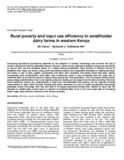Rural poverty and input use efficiency in smallholder dairy farms in western Kenya

View/
Date
2014-09Author
Otieno, Dennis
Nyabundi, J.
Odhiambo, M. O.
Metadata
Show full item recordAbstract
Increasing agricultural productivity depends on the adoption of modern technology that involves the use of modern improved technical embodied inputs. However, farmers have different production decisions and ability to source and use the available inputs. In a study among smallholder dairy farmers in Western Kenya to establish their input use levels using profit maximizing method and marginality principles in making decision, the levels of use of land, capital, concentrate and labor were analyzed. The study found that land, capital, concentrate were underutilized while labor was excessively used. It was concluded that the large size of unskilled labor force was the cause of high poverty among the rural population. This is because farmers prefer using cheap unskilled labor that is not highly productive leading to low output from the dairy farming. The other three expensive factors are underutilized. It was thus recommended that poverty can be reduced through improvement of labor skills through training and farmer education on use of modern production technology packages would encourage their use and lead to increased agricultural production. Based on Say’s law the demand for skilled labor would lead to a decline of unskilled labor force in the rural areas due to increasing better wage rates and thus a decline in the levels of poverty.
URI
https://www.e3journals.org/cms/articles/1389613955_Otieno%20et%20al.pdfhttp://hdl.handle.net/123456789/4707
Collections
- Journal Articles (BE) [350]
